
|
|
17 December, 2001
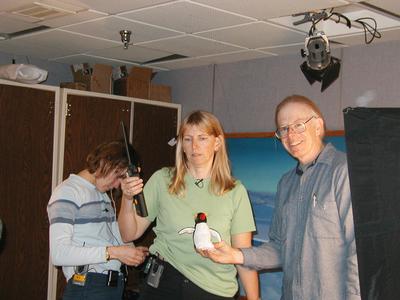
Members of the Exploratorium webcast team (Julie Konop, Mary Miller, and Paul Doherty) are getting ready for an online broadcast. I felt very fortunate to have the opportunity to meet with the Exploratorium Webcast team while I was in McMurdo. Noel Wanner (the technical producer), Julie Konop, (the video producer), Mary Miller (producer and science writer), and Paul Doherty (senior staff scientist, physicist, author, and teacher) are in the process of making over 40 webcasts during their six-week stay in Antarctica. They will be experiencing Antarctica from McMurdo to the South Pole and doing live online broadcasts between December 1, 2001 to January 12, 2002. These broadcasts include video footage of life in Antarctica. The broadcasts may be accessed from their calendar at www.exploratorium.edu (Click on "event archive" listed under "Highlights"). The video clips spotlight such topics as penguins, the "Blizzard", Mt. Erebus, diving under ice, and the South Pole. The Exploratorium graciously invited me to parcticipate on the December 16th webcast, (which is December 17th for Antarctica). I learned a great deal from the Exploratorium team during this visit. This is not only a wonderful and informative web site for teachers (pre-tested activities), but also an amazing website for all to "experience" Antarctica and other regions of the world. The Exploratorium, which is housed in the Palace of Fine Arts in San Francisco, is a "hands-on" museum and education center. Paul Doherty's web page is also a wonderful resource: www.exo.net/~pauld. Along with training teachers (to date: over 81,000 teachers in 37 states) and museum staff, the Exploratorium conducts research, and supports students pursuing advanced degrees in science education. The Exploratorium is a model of how "science centers" (in an informal science setting, such as museums and zoos) can work directly with schools to enhance science education. I especially wanted to meet up with the Exploratorium because the Exploratorium's "ice balloon" activity has made a huge impact on my students for the past three years. As a classroom teacher, I have seen first-hand how this "hands-on" investigative approach to learning encourages students to "ask" questions, before investigating to discover the answer. Students are familiar with one level of "knowing", which involves answering questions and learning content. The "inquiry" approach involves a higher level of "knowing" because the students are given the opportunity to learn how to "ask" good questions. This "inquiry-based" approach stresses the need for students to investigate one of their own questions. The students discover that one question will often lead to other questions. This learning process teaches students how to think and apply what they are learning. I believe in "inquiry-based" learning because I have seen the excitement generated as students work together in teams to investigate their own questions. I have personally seen how this "what-if/ investigative" approach motivates students to find additional information as to the "why" or the "what". Making discoveries leads students to want to know more content. The Exploratorium introduced activities, which helped change my teaching. As my teaching changed, I noticed changes within my students. Meeting the Exploratorium team was yet another unexpected highlight of my experience in Antarctica.
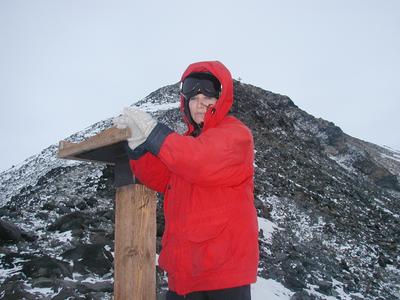
Walking up Observation Hill with Dr. Sergei Korsun was also another highlight. We stopped at the post midway up the hill to look at the view. The surrounding area was dusted in snow. I have been scheduled to leave Antarctica since December 13th, but the blizzard has kept me from leaving. Although it is almost midnight, I didn't want to miss the opportunity to climb Ob Hill before going home. The blizzard that detained me also prevented me from making the climb sooner. Since I was scheduled to leave on the next plane, I decided to step through snow (sometimes knee-deep) to reach the cross at Ob Hill. This steep climb was worth every step. Observation Hill is located on Ross Island, at the southern end of the Hut Point Peninsula. McMurdo Research Station is in the shadow of this 230 meter (800-foot) volcanic cone. The memorial cross at the top of the hill was erected in memory of Scott, Wilson, Bowers, Oates, and Evans who died in March 1912 on their return from their legendary expedition to the South Pole.
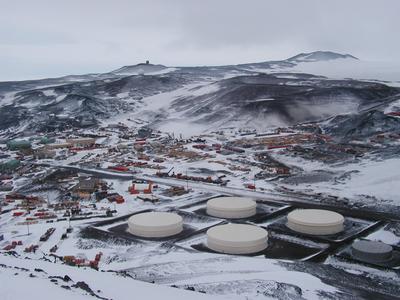
View of crater, fuel storage tanks, and McMurdo from Observation Hill
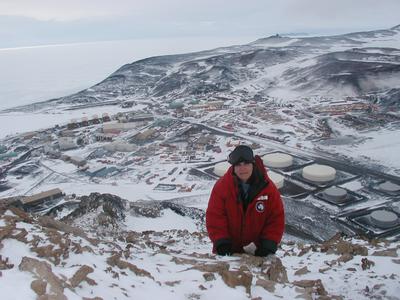
Experiencing a blizzard during the Antarctic summer is rare, so viewing McMurdo dusted in snow was not only beautiful, but also a highly appreciated sight. The wind began to pick up as we neared the summit.
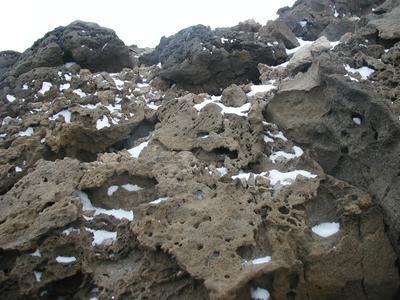
The weathered rocks near the top of Observation Hill show evidence of a harsh environment. The extreme cold conditions tempered with blasts of high winds add character to these rocks. When I reached the summit (top), the wind was blowing so hard, I couldn't stand up. I suddenly understood how the rock eroded, as I, too, felt like a part of me might get swept away by the wind.
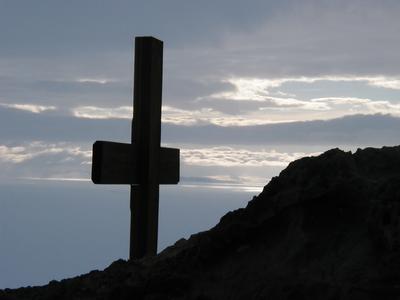
On the morning of January 20, 1913, a group led by the leader of the southern search party who found Scott's last camp, hauled this beautiful cross up Observation Hill. The journey took eight hours as each half of the cross was carried by two sledges across the sea ice and hauled to the summit. It had taken carpenter Frank Davies thirty hours to make this cross from Australian jarrah. The inscription on the cross was chosen from Tennyson's Ulysses by one of the men on Scott's last expedition (Cherry-Garrard). The inscription, "To strive, to seek, to find, and not to yield" is a poignant statement to fit this expedition, and life in general. The cross has blown down on two occasions (1974 and 1993). It was rededicated in 1994, when 15 teams consisting of 120 New Zealanders and Americans, hand-carried it to the top of Observation Hill. I couldn't imagine leaving Antarctica without making this climb.

Thank you, Dr. Sergei Korsun, for making this "climb" with me. Seeing this cross and the surrounding snow-dusted area will be a wonderful lifetime memory.
Contact the TEA in the field at
.
If you cannot connect through your browser, copy the
TEA's e-mail address in the "To:" line of
your favorite e-mail package.
|
